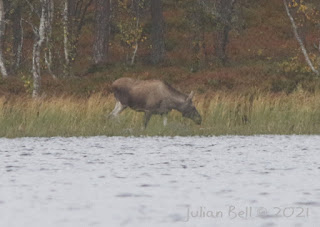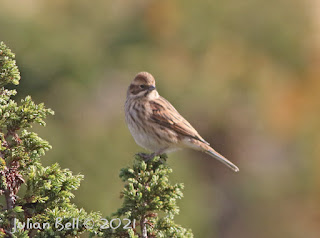At odds with the rest of the birding community I chose to head east instead of west during the second half of September. My thoughts being if it is peak time in the west then it must also be peak season in the east:)
As usual Engerdal did not disappoint and punched well above its weight.
My first day out on 16 September produced plenty of birds and Beaver. Best bird in an Engerdal context was a Buzzard musvåk at Kvilten and another at Heggeriset.
My usual round of Galten - Drevsjø - Heggeriset produced good numbers of migrants at Galten and a nice female Goshawk hønsehauk looking for prey. The expected Black-throated Divers storlom were joined by a Slav Grebe horndykker and the usual wildfowl were present. Migrant passerines included Reed Buntings sivspurv, Dunnock jernspurv, Chiff-chaff gransanger and plenty more besides. A lone Herring Gull gråmåke rested on rocks out on the lake.
Merganser siland at Galtsjøen
This was followed by a walk at Lisæter and a walk around Hyllsjøen. Kestrel tårnfalk, flocks of Brambling bjørkefink, the usual thrushes, a couple of Rough-legged Buzzards fjellvåk and plenty more were seen.
On 17 September it was a late and lazy start but whilst waiting for my better half to get ready I clocked up a couple of Black Woodpecker svartspett, Dipper fossekall and more. This was followed by a new walk - Galtåsen, here a flock of 30 Parrot Crossbill furukorsnebb fed in the trees and a few Siberian Jay lavskrike fed on the forest floor. Treecreeper trekryper and Crested Tits toppmeis joined the usual suspects in the woods.
Dipper fossekall
Siberian Jay lavskrike
Just as it got dark I received a message about a strange bird - a mobile phone image of what was obviously a phalarope although the exact species was not evident, an interesting sighting whatever it turned out to be. Mostly because it was dark and partly because we were already at the only restaurant in the area I didn't actually leave immediately. Instead I left the house before first light the nest day to head up to Vurrusjøen (having already woken up twice at 0330 and 0430 in the hope that it might soon be light!). Here I had Grey Wagtail vinterle, a couple of Whoopers sangsvane and a reasonable selection of wildfowl. But no phalarope.
I opted to check a few other localities before returning and could not believe my eyes - a GREY PHALAROPE polarsvømmesnipe - only the second record for Hedmark (previous was September 1969!!!). This is the first time I have ever gone for a bird in Engerdal, hopefully it won't be the last. My family is all too familiar with me leaving the house in the middle of making dinner back in Øygarden but this is the first time they had to experience this in the tranquil world that is / was Engerdal:)
Engerdal's first and Hedmark's second ever Grey Phalarope polarsvømmesnipe
After that everything seemed rather quiet but another Goshawk hønsehauk put in an appearance at Heggeriset.
On 19 September I did not actually go out birding but whilst digging potatoes a nice flock of 47 Pinkfeet kortnebbgås headed south over the house, first record for Engerdal this year.
Part of a flock of migrating Pinkfeet kortnebbgås - quite possibly coming from the same place as the phalarope.
The following day it was back to the grindstone. Galtsjøen produced four Slav Grebes horndykker, a late Yellow Wagtail gulerle, a Tree Pipit treiplerke, Kestrel tårnfalk and four Jays nøtteskrike among other things. An Osprey fiskeørn ate a mammoth catch (sik - no idea of the English name) at Galthåen whilst in the background an elg grazed at the water's edge.
Back home a Mistle thrush duetrost was the best sighting.
Osprey fiskørn (late!) with a sik (whitefish?)
Grazing Elg
Robin rødstrupe in the garden - in contrast to my garden back west this bird will soon leave as the cold sets in.
Four Slav grebes horndykker
Dull weather early on 20 September prevented me going ahead with my planned walk so it was rather a case of the same as usual with the addition of a female Capercaille storfugl flying over the road. None the less a very pleasant and productive morning out and about. The clouds then lifted and it was up to Svarthammeren where Golden Eagle kongeørn, Kestrel tårnfalk, a few Ring Ousel ringtrost and a good movement of Siskin grønnsisik were the highlights.
Reed Bunting sivspurv have largely moved down to the valleys but some remain in the hills too.
One of three Ring Ousel ringtrost seen
Roe Deer rådyr living dangerously now that the hunting season has started...
At least 67 species noted, not bad at all:) Engerdal year list now at 107 - my best year yet despite not having been there during the summer!




























































